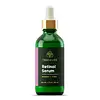What's inside
What's inside
 Key Ingredients
Key Ingredients

 Benefits
Benefits

 Concerns
Concerns

 Ingredients Side-by-side
Ingredients Side-by-side

Aloe Barbadensis Leaf
MaskingCassia Angustifolia Seed Polysaccharide
Skin ConditioningHamamelis Virginiana Water
AstringentPentylene Glycol
Skin ConditioningPhospholipids
Skin ConditioningRetinol
Skin ConditioningPolysorbate 20
EmulsifyingPotassium Phosphate
BufferingHydroxyethylcellulose
Emulsion StabilisingCarrageenan
Simmondsia Chinensis Seed Oil
EmollientTriticum Vulgare Germ Oil
EmollientTocopheryl Acetate
AntioxidantCamellia Sinensis Callus
AntimicrobialPropolis Wax
EmollientSodium Benzoate
MaskingPotassium Sorbate
PreservativeEthylhexylglycerin
Skin ConditioningAloe Barbadensis Leaf, Cassia Angustifolia Seed Polysaccharide, Hamamelis Virginiana Water, Pentylene Glycol, Phospholipids, Retinol, Polysorbate 20, Potassium Phosphate, Hydroxyethylcellulose, Carrageenan, Simmondsia Chinensis Seed Oil, Triticum Vulgare Germ Oil, Tocopheryl Acetate, Camellia Sinensis Callus, Propolis Wax, Sodium Benzoate, Potassium Sorbate, Ethylhexylglycerin
Aloe Barbadensis Leaf Juice
Skin ConditioningWater
Skin ConditioningNiacinamide
SmoothingCyclodextrin
AbsorbentGlycerin
HumectantCaprylic/Capric Triglyceride
MaskingGluconolactone
Skin ConditioningSqualane
EmollientBisabolol
MaskingCeramide NP
Skin ConditioningMichelia Alba Flower Oil
MaskingHamamelis Virginiana Water
AstringentCamellia Oleifera Leaf Extract
AstringentRubus Chamaemorus Seed Oil
Skin ConditioningSodium Hyaluronate
HumectantTocopheryl Acetate
AntioxidantVaccinium Macrocarpon Fruit Extract
AstringentRetinal
Skin ConditioningPolygonum Cuspidatum Extract
Skin ConditioningPentylene Glycol
Skin ConditioningMaltodextrin
AbsorbentLonicera Japonica Flower Extract
Skin ConditioningLonicera Caprifolium Flower Extract
PerfumingXanthan Gum
EmulsifyingSodium Benzoate
MaskingSodium Gluconate
Skin ConditioningPolysorbate 20
EmulsifyingCitrus Grandis Peel Oil
MaskingCitrus Aurantium Dulcis Peel Oil
MaskingCitrus Aurantium Bergamia Fruit Oil
MaskingAlcohol
AntimicrobialAlcohol Denat.
AntimicrobialAloe Barbadensis Leaf Juice, Water, Niacinamide, Cyclodextrin, Glycerin, Caprylic/Capric Triglyceride, Gluconolactone, Squalane, Bisabolol, Ceramide NP, Michelia Alba Flower Oil, Hamamelis Virginiana Water, Camellia Oleifera Leaf Extract, Rubus Chamaemorus Seed Oil, Sodium Hyaluronate, Tocopheryl Acetate, Vaccinium Macrocarpon Fruit Extract, Retinal, Polygonum Cuspidatum Extract, Pentylene Glycol, Maltodextrin, Lonicera Japonica Flower Extract, Lonicera Caprifolium Flower Extract, Xanthan Gum, Sodium Benzoate, Sodium Gluconate, Polysorbate 20, Citrus Grandis Peel Oil, Citrus Aurantium Dulcis Peel Oil, Citrus Aurantium Bergamia Fruit Oil, Alcohol, Alcohol Denat.
 Reviews
Reviews

Ingredients Explained
These ingredients are found in both products.
Ingredients higher up in an ingredient list are typically present in a larger amount.
Hamamelis Virginiana Water is made by distilling parts of the witch hazel plant. You can also call this ingredient "witch hazel water".
The name 'Hamamelis Virginiana Water' refers to the distillation product used in cosmetics. On the other hand, 'Witch Hazel' refers to the active drug ingredient.
Unless it is specified to be non-alcohol, many types of witch hazel ingredients are distilled in denatured alcohol.
Witch Hazel water is an astringent, anti-inflammatory antioxidant, and antibacterial ingredient.
It contains tannins. Tannins have a drying effect when used on skin by constricting proteins. The constriction also minimizes the appearance of pores.
Both the tannins and fragrance found in witch hazel may be skin-sensitizing.
Witch hazel water gets anti-inflammatory and antibacterial properties from its catechin and gallic acid content.
Indigenous groups have used witch hazel to help treat inflammation in North America for centuries.
Learn more about Hamamelis Virginiana WaterPentylene glycol is typically used within a product to thicken it. It also adds a smooth, soft, and moisturizing feel to the product. It is naturally found in plants such as sugar beets.
The hydrophilic trait of Pentylene Glycol makes it a humectant. As a humectant, Pentylene Glycol helps draw moisture from the air to your skin. This can help keep your skin hydrated.
This property also makes Pentylene Glycol a great texture enhancer. It can also help thicken or stabilize a product.
Pentylene Glycol also acts as a mild preservative and helps to keep a product microbe-free.
Some people may experience mild eye and skin irritation from Pentylene Glycol. We always recommend speaking with a professional about using this ingredient in your routine.
Pentylene Glycol has a low molecular weight and is part of the 1,2-glycol family.
Learn more about Pentylene GlycolPolysorbate 20 is made by combining ethoxylation of sorbitan, ethylene oxide, and lauric acid. It is a mild cleansing agent, surfactant, and emulsifier.
As a surfactant, it helps collect dirt and oils for washing. Emulsifiers prevent oils and water from separating.
Polysorbate 20 also adds scent to a product. Since it is made using sorbitol, it has a sweet scent. Sorbitol can also be found in fruits such as apples and peaches.
The lauric acid used to create Polysorbate 20 is often derived from coconuts.
Polysorbate 20 may not be fungal acne safe.
Learn more about Polysorbate 20Sodium Benzoate is a preservative. It's used in both cosmetic and food products to inhibit the growth of mold and bacteria. It is typically produced synthetically.
Both the US FDA and EU Health Committee have approved the use of sodium benzoate. In the US, levels of 0.1% (of the total product) are allowed.
Sodium benzoate works as a preservative by inhibiting the growth of bacteria inside of cells. It prevents the cell from fermenting a type of sugar using an enzyme called phosphofructokinase.
It is the salt of benzoic acid. Foods containing sodium benzoate include soda, salad dressings, condiments, fruit juices, wines, and snack foods.
Studies for using ascorbic acid and sodium benzoate in cosmetics are lacking, especially in skincare routines with multiple steps.
We always recommend speaking with a professional, such as a dermatologist, if you have any concerns.
Learn more about Sodium BenzoateTocopheryl Acetate is AKA Vitamin E. It is an antioxidant and protects your skin from free radicals. Free radicals damage the skin by breaking down collagen.
One study found using Tocopheryl Acetate with Vitamin C decreased the number of sunburned cells.
Tocopheryl Acetate is commonly found in both skincare and dietary supplements.
Learn more about Tocopheryl Acetate